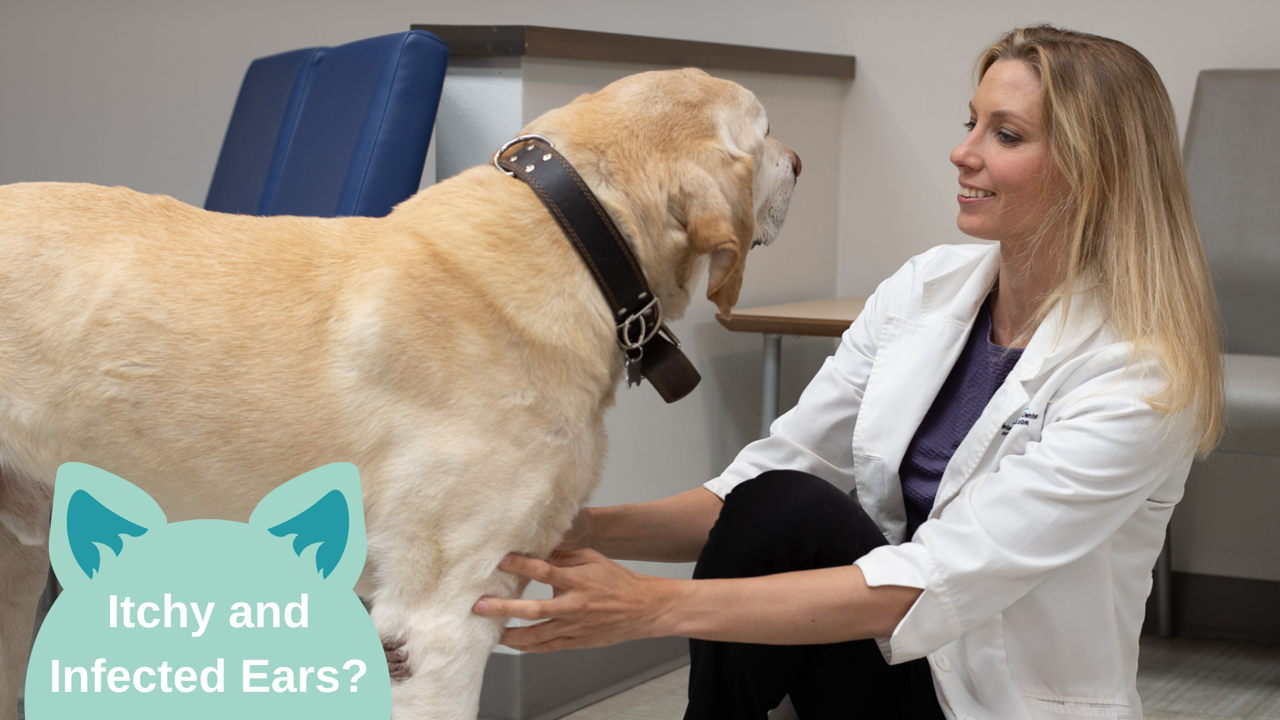Itchy & Infected Ears in Dogs & Cats: Causes & Treatments
Itchy & Infected Ears in Dogs & Cats: Causes & Treatments

A pet with itchy ears: Your dog or cat is shaking her head, pawing at his ears, or trying to rub her ears on the ground. Behavior such as this can indicate inflammation of the extended ear canal, or otitis externa, and can cause pets and pet parents quite a bit of distress. In a recent Facebook Live, Dr. Jennifer Bentley of Veterinary Referral Center of Central Oregon weighed in itchy and infected ears in dogs and cats, and what pet parents can do about it.
Pet Ear Inflammation vs Pet Ear Infection
Inflammation of the external ear canal does not necessarily indicate that your dog or cat has an infection. However, it does require treatment, as inflammation can lead to infection. The first step is to swab the external ear canal and make a slide that can be assessed under the microscope. This will indicate the presence of bacteria or yeast, as well as tell your vet the level of infection, if present. Once the scope of the problem is known, a prognosis can be made and treatment can begin.
What Causes Itchy & Infected Ears in Pets such as Dogs and Cats?
Contrary to popular thought, swimming and floppy ears may have little to do with ear trouble. Allergies are often to blame for inflammation, says Dr. Bentley, both food-related and environmental.
Endocrine-type diseases that attack the immune system may be to blame. Your vet may check for hypothyroidism and for Cushing’s disease. Foreign bodies cause ear distress, as well as masses. Cats can be particularly prone to developing polyps in the ear canal.
Treating Ear Problems in Dogs & Cats
Discomfort and visible irritation will be the first indicators of ear problems, but a vet needs to examine the ear canal more closely to see the big picture. The ear canals of dogs and cats are L-shaped, which means your vet needs an otoscope to see the horizontal portion of the canal. With an otoscope, we gauge the integrity of the tympanic membrane, or ear drum, and check for erosions and other irritations in the skin.
Treatment often involves topical therapy, as well as anti-itch therapies including Apoquel and steroids to reduce inflammation. With treatment, symptoms may disappear in one week. However, to be sure that an infection resolves completely, a full course of treatment typically lasts three weeks.
Middle Ear Infections
Infection can pass through the tympanic membrane, or ear drum, and cause otitis media, or middle ear disease. The middle ear is a kind of boney pocket that can’t be reached by topical treatments or helped by oral treatments that travel through the blood vessels. Treatment for middle ear disease involves administering anesthesia, breaking open the tympanic membrane, and flushing the area. A ruptured ear drum will indicate middle ear disease. The only other way to diagnose otitis media is with a CT scan, as an x-ray cannot penetrate the boney pocket.
VRCCO uses a special video otoscope to access the ear canal. Equipped with a light source and camera, it also has a port. Via the port, we can access the area to remove objects as well as administer an ear flush.
Surgical intervention may be necessary if your pet develops end-stage ear disease. This means inflammation has triggered a buildup and hardening of skin. Eventually, the ear canal can calcify to one big piece of bone. In this case, surgery is necessary to remove the entire ear canal. At VRCCO, we recommend pet parents work with their vet and veterinary dermatologist to keep inflammation down and avoid surgery.
Pet Allergies & Ear Troubles
Allergies can cause inflammation of the ear canal, and, in rare cases, irritate the situation further. Occasionally, a dog or cat will be allergic to a prescribed ear flush. The important thing is to screen the product for ingredients to avoid contact with the irritant in the next product.
Home Remedies Can Do More Harm than Good
As tempting as it is to apply a home remedy to your dog or cat’s ears to alleviate the itch, home remedies can irritate the situation further, as well as delay treatment that may work more effectively. A common application is water and vinegar. Although it’s true that vinegar kills yeast, it can sting existent erosions, making it all the more difficult to treat your pet.
Oils such as rosemary and oregano oil are probably not harmful, per se, and may break up wax. Ultimately, they don’t work to improve an inflammatory situation in the ear canal.
Witch hazel is astringent, which works to dry out the skin. It is not a product designed for use in pets’ ears, however, and can actually promote bacterial growth.
A main issue is that pet parents cannot adequately see into their pets’ ears, and so cannot be aware of the scope of the problem. At VRCCO, Dr. Bentley prescribes specific treatments for specific conditions. When treating for allergies, for example, she may prescribe an ear flush with hydrocortisone to tamp down inflammation to address the problem from every angle.
If your dog or cat is showing signs of ear trouble, get to the vet for an exam to get to the root of the issue. The veterinarians and staff at VRCCO offer veterinary dermatology, advanced scanning, and veterinary surgery to support pets, pet parents and their vets.


